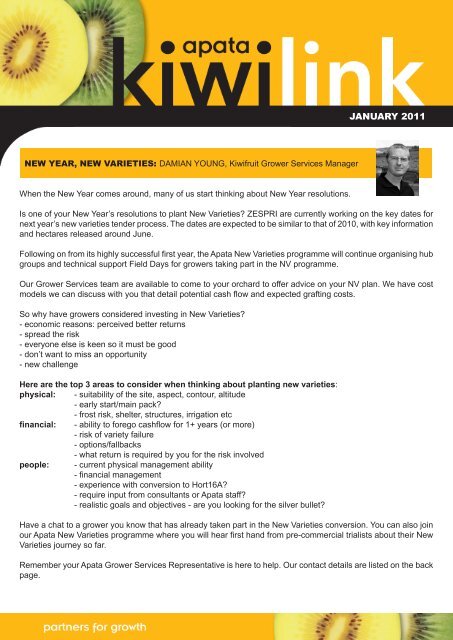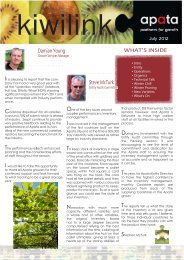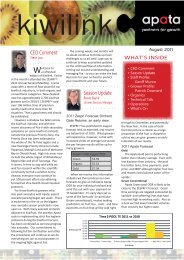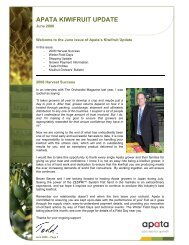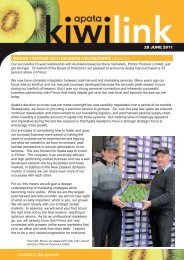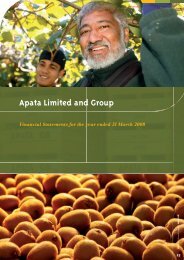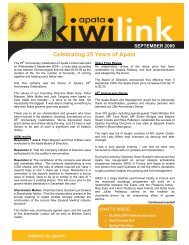Create successful ePaper yourself
Turn your PDF publications into a flip-book with our unique Google optimized e-Paper software.
NEW YEAR, NEW VARIETIES: DAMIAN YOUNG, Kiwifruit Grower Services Manager<br />
When the New Year comes around, many of us start thinking about New Year resolutions.<br />
<strong>JANUARY</strong> <strong>2011</strong><br />
Is one of your New Year’s resolutions to plant New Varieties? ZESPRI are currently working on the key dates for<br />
next year’s new varieties tender process. The dates are expected to be similar to that of 2010, with key information<br />
and hectares released around June.<br />
Following on from its highly successful first year, the <strong>Apata</strong> New Varieties programme will continue organising hub<br />
groups and technical support Field Days for growers taking part in the NV programme.<br />
Our Grower Services team are available to come to your orchard to offer advice on your NV plan. We have cost<br />
models we can discuss with you that detail potential cash flow and expected grafting costs.<br />
So why have growers considered investing in New Varieties?<br />
- economic reasons: perceived better returns<br />
- spread the risk<br />
- everyone else is keen so it must be good<br />
- don’t want to miss an opportunity<br />
- new challenge<br />
Here are the top 3 areas to consider when thinking about planting new varieties:<br />
physical: - suitability of the site, aspect, contour, altitude<br />
- early start/main pack?<br />
- frost risk, shelter, structures, irrigation etc<br />
financial: - ability to forego cashflow for 1+ years (or more)<br />
- risk of variety failure<br />
- options/fallbacks<br />
- what return is required by you for the risk involved<br />
people: - current physical management ability<br />
- financial management<br />
- experience with conversion to Hort16A?<br />
- require input from consultants or <strong>Apata</strong> staff?<br />
- realistic goals and objectives - are you looking for the silver bullet?<br />
Have a chat to a grower you know that has already taken part in the New Varieties conversion. You can also join<br />
our <strong>Apata</strong> New Varieties programme where you will hear first hand from pre-commercial trialists about their New<br />
Varieties journey so far.<br />
Remember your <strong>Apata</strong> Grower Services Representative is here to help. Our contact details are listed on the back<br />
page.
ORCHARD OBSERVATIONS: WADE HUNKIN, <strong>Apata</strong> Technical Services Manager<br />
In general we are encouraged at what we are seeing in orchards during our first visits for the new year. Fruit has sized well in<br />
both Green and Gold orchards, fruit is quite clean and shape in green much better than last year. What a difference a warmer<br />
late spring can make.<br />
The wet weather just at the end of green pollination has definitely had an impact with a number of growers reporting losses<br />
due to sclerotinia despite their best efforts with fungicides. Often fruit parts were slow to drop from fruit so provided an<br />
excellent site for sclerotinia to grow. While there was some fruit drop, scarring appears to be the most widespread issue.<br />
Thinning strategies<br />
GOLD - As already noted Gold fruit has sized well, there is little blemish apparent and low numbers of undersize fruit. For<br />
most there is little to be gained in a thinning round now, better to leave the fruit there until closer to harvest when a final<br />
cosmetic round is recommended.<br />
HAYWARD - Ideally the first round of thinning will have been done by now on green crops and they will be looking good.<br />
Certainly there are not the same problems with square fruit as last year but the flats are still there. The main concern we have<br />
is around numbers particularly on spurs. While so far fruit has sized well there is risk that it will not continue to do so where<br />
the leaf to fruit ratio is low. Often overall numbers are still high so a good strategy will be to bring back the spurs to 2-3 fruit<br />
only in the course of reducing to 45-50 fruit per square meter overall. This needs to be done as soon as possible to get the<br />
maximum benefit.<br />
Its worth reminding oneself what fruit per square meter means in Trays per ha. Assuming a typical 10% male area and<br />
average size of 33 the table below demonstrates the number of resulting trays per ha at different levels of conversion to class<br />
1 (allowing for both packing and thinning rejects)<br />
Conversion to Class 1<br />
Fruit per m2 70% 75% 80% 85%<br />
30 5727 6136 6545 6955<br />
35 6682 7159 7636 8114<br />
40 7636 8182 8727 9273<br />
45 8591 9205 9818 10432<br />
50 9545 10227 10909 11591<br />
55 10500 11250 12000 12750<br />
60 11455 12273 14182 15068<br />
65 12409 13295 14182 15068<br />
70 13364 14318 15273 16227<br />
75 14318 15341 16364 17386<br />
A monitoring record is required to spray. The counting<br />
procedure is set out in the KiwiGreen fact sheet on<br />
PVH:<br />
• Count the number of adult PVH in a two minute period<br />
in a bay (or vine if that is more convenient).<br />
• To assess the need to spray a whole block, do 5<br />
separate counts per block, (2 in the outer rows and 3<br />
from middle areas).<br />
• To assess the need to spray outer rows only do 2-3<br />
counts from each outer row.<br />
The easiest way to spot them is to check the new shoots<br />
in the leader zone where there is normally more light.<br />
So if you have 70 fruit per square meter even if you remove 15%<br />
now and have a 15% reject rate at packing you would be looking at<br />
over 13000 trays per ha – exciting but realistic? For Gold maybe but<br />
Green?<br />
Pest Levels<br />
Monitoring for leafroller has commenced in both Green and Gold<br />
and pressures appear low for now. Some scale monitoring has been<br />
carried out on gold with very low levels of scale being observed.<br />
Passion vine hoppers nymphs have been well in evidence, with<br />
adults beginning to appear now. The only product available for use<br />
in orchard is pyrethrum, it is broken down by UV light so apply in the<br />
late afternoon for maximum impact. The nymphs appear easier to kill<br />
so should be targeted first.
Trunk Girdling<br />
This year more than ever growers are asking about trunk girdling.<br />
The advantages of a summer girdle are an increased dry matter and greater return bloom at the possible expense of<br />
compromising vine health. A trunk girdle is somewhat easier to apply than cane girdling and gives a more consistent result but<br />
is more invasive and getting it wrong has more impact so a cane girdle might be a comfortable halfway house. See the January<br />
2008 Kiwifruit Journal. If your vines are healthy - a good canopy, previous girdles have healed quickly and well and plenty of<br />
white feeder roots – then the economic advantages of a summer girdle are hard to ignore. One reason not to may be if you are<br />
considering a new variety conversion.<br />
So look closely at your orchard before making the decision – we are happy to assist. If you are girdling identify any vines that<br />
need a year or two off and mark them clearly. Make sure the job is done properly, it is most important to not go too deep into the<br />
xylem while ensuring all the phloem tissue has been removed. See the Kiwitech bulletin on the subject for a thorough reminder<br />
and the January 2008 Kiwifruit Journal contained a good article on different techniques and options. On orchard hygiene is<br />
increasingly important - sterilise equipment frequently.<br />
With fruit already large (in gold perhaps as a result of extra Benefit applications) and a wetter summer there is increased risk of<br />
lower dry matter levels. There is no evidence of PSA infection from trunk girdling that we are aware of so on balance proceed<br />
with trunk girdling.<br />
The following is taken from ZESPRI’s PSA: Cane and Trunk Girdling Version 1<br />
Growers should be particularly cautious girdling in orchards when bacterial leaf spot symptoms are seen.<br />
• Cane girdling is considered safer but will not give the same level of response as trunk girdling.<br />
• Covering girdles is not recommended.<br />
• An information sheet ‘Psa Orchard Hygiene’ is available on The Canopy (www.zespricanopy.com) which outlines the<br />
increased general hygiene measures required to manage Psa.<br />
Girdling Equipment Hygiene<br />
• As an absolute minimum, it is critical that operators check that any tools entering the orchard have been cleaned with soap<br />
or detergent and water to remove any plant residues and then sterilised.<br />
• More frequent sterilisation of tools is recommended, especially in orchards where evidence of Psa like symptoms have<br />
been observed. Ensuring tools are clean and sterilised between each girdle provides the best protection but will not be<br />
practical in most cases.<br />
• To ensure effective sterilisation, tools need to be dipped in a 10% bleach solution, 70% alcohol solution or commercial<br />
disinfectant for at least two minutes.<br />
•<br />
Application of a sterilising solution or copper based spray to girdle wounds has been tried by some growers in Italy, but<br />
ZESPRI has no evidence that this reduces the risk of infection. Chlorine based solutions should be avoided as these have<br />
not been tested.<br />
Males<br />
A follow-up round of pruning is required later in January to get the best out of the males next pollination. The new strong canes<br />
should be button stubbed and the short terminated shoots retained. This is a further opportunity to reduce the height of the<br />
plant by removing the high points. Heavy cuts should be protected with a suitable seal.
PSA UPDATE: KIWIFRUIT VINE HEALTH<br />
Psa isolate test results provide a clearer picture of Psa in the Te Puke region<br />
Further Psa isolate test results have been received by Kiwifruit Vine Health (KVH) this week. An additional 15 leaf<br />
samples taken from Psa affected orchards in the Te Puke region have been identified as positive for an Italianlike<br />
isolate.<br />
This takes the current number of orchards with an Italian-like isolate to 25 out of the total of 86 Psa affected<br />
orchards in the greater Te Puke region. These orchards are all confined to an area south of Te Puke.<br />
A new “Te Puke Psa Priority Zone” has been established which surrounds these orchards and includes 97 others.<br />
Psa isolate testing is being prioritised for orchards within or near this zone. It could take a few weeks to work<br />
though this complex process.<br />
Growers within or near this zone are strongly encouraged to use a copper-based spray to help minimise Psa<br />
spread during the forecast rain and wind in the next week or so.<br />
All growers are urged to be vigilant with monitoring and continue the recommended orchard hygiene practices<br />
above.<br />
Sampling Process<br />
Orchard sampling and isolate testing of Psa affected orchards recommences this week and results will come through<br />
in batches on a regular basis. Isolate test results will be communicated to growers as they are available.<br />
Sampling and isolate testing of orchards in the Te Puke region are being prioritised to provide a better picture<br />
of the location of the Italian-like Psa isolate within the region. The inclusion of samples from other regions will<br />
provide an indication of whether the Italian-like isolate is contained within this region.<br />
Following the identification of both an Asian-like Psa isolate and a potentially more damaging Italian-like Psa<br />
isolate, KVH has been working closely with orchardists to aggressively manage Psa.<br />
A dedicated Psa Grower Liaison Manager is working closely with Psa affected growers with the Italian-like isolate<br />
to coordinate comprehensive orchard assessment and to define, agree and act upon a Psa Orchard Management<br />
Strategy.<br />
Psa Update:<br />
The number of New Zealand orchards affected by Psa remains at 122;<br />
- 52 are Hayward orchards,<br />
- 70 are Hort 16A orchards or Hort 16A and Hayward orchards.<br />
Psa affected orchards have been identified in Hawke’s Bay, Tauranga, Whakatane / Edgecumbe, Waikato, Golden<br />
Bay, Motueka, and Gisborne, Franklin, Katikati and Horowhenua.<br />
The majority of Psa symptoms identified are considered primary symptoms – leaf spotting. To date approximately<br />
11 hectares have had an independent assessment and been removed under the Psa Orchard Management<br />
Strategy. All growers are strongly encouraged to adhere to the best practice orchard management guidelines and<br />
operational processes. Alignment of on-orchard practices with the agreed Orchard Management Strategy will<br />
ensure eligibility for funding support.<br />
Key Contacts:<br />
Growers should direct questions and enquiries relating to Psa to your post harvest supplier; your ZESPRI Grower<br />
Liaison Manager; or the ZESPRI Grower Contact Centre (0800 155 355 or contactcanopy@zespri.com).<br />
Further information about KVH, best practice orchard management and the Psa Orchard Management Strategy<br />
can be found at www.kvh.org.nz or www.zespricanopy.com.
<strong>2011</strong> GROWER CONTACTS<br />
Growers will receive their ZESPRI contract packs in the first week of February. To ensure a smooth start<br />
to the season, all forms must be completed and returned to ZESPRI by the end of February <strong>2011</strong>.<br />
Growers must remember to get their entity (<strong>Apata</strong> Suppliers Entity Ltd) to sign<br />
their <strong>2011</strong> Supply Agreement (yellow form) before sending it back to ZESPRI.<br />
You can post your <strong>2011</strong> Supply Agreement to <strong>Apata</strong> to be signed, or bring it<br />
into our Turntable Hill Road office.<br />
If you have any queries or need help completing the forms, please call the<br />
ZESPRI Grower Contact Centre on 0800 155 355. We’d also like to remind<br />
you that your <strong>Apata</strong> Grower Services Representative will be visiting you in<br />
February to take you through the <strong>2011</strong> <strong>Apata</strong> Kiwifruit Services Agreement.<br />
BAY OF PLENTY GROWSAFE COURSES<br />
There are two options for GrowSafe certification on offer in the Bay of Plenty: half-day recertification for<br />
those with existing certificates, and full day for new candidates:<br />
Renewal:<br />
Half-day Re-certification Course dates in Katikati: 3 February, 3 March, 7 April, 5 May, 2 June.<br />
This is a half-day course, and is run by Eddie Biesiek, through Certified Ltd.<br />
The course is preceded by some pre-course work which is sent out to each candidate at least a week prior to the course.<br />
The half-day discussion group finishes off the paperwork, and we cover any HSNO or GrowSafe issues the candidates want<br />
to discuss.<br />
Candidates must be able to produce copies of their existing GrowSafe and Approved Handler certificates, plus three Spray<br />
Diary records.<br />
Cost is $250 per person, inclusive of GST, payable to Certified Ltd.<br />
The outcome is new 5 year GrowSafe Introductory, and Approved Handler Certificates for Agrichemical use, storage and<br />
disposal.<br />
The GrowSafe certificate is re-issued with the same number. To book a place, please contact Eddie Biesiek, Certified Ltd,<br />
07 549 4775 or 021 494 042.<br />
New Candidates:<br />
Full one-day course – 8.30am to 4.00pm at the Bay of Plenty Polytechnic, Windermere: 18 February, 15 April, 17 June<br />
19 August, 14 October, 9 December<br />
The one-day course, to Unit Standards 21563 and 21564, is being offered by Bay of Plent Polytechnic for $410 per person<br />
inclusive of GST. The outcome is both the GrowSafe Introductory and Approved Handler Certificates for Agrichemical use,<br />
storage and disposal.<br />
For enrolments, please contact The Bay of Plenty Polytechnic direct on 0800 267 7659, ext 6891.
<strong>Apata</strong> Contact Details<br />
<strong>Apata</strong> Turntable Hill Road, RD2 Katikati Phone: 07 552 0911 Fax: 07 552 0666<br />
Pyes Pa 83 Pyes Pa Road, Tauranga Phone: 07 543 1211 Fax: 07 543 0096<br />
Northland 37 Southend Avenue, Whangarei Phone: 09 430 8003 Fax: 09 430 8006<br />
Kiwifruit Services Contact Details<br />
reception@apata.co.nz www.apata.co.nz<br />
Kiwifruit Grower Services Manager GM Grower Services<br />
Damian Young 027 500 8586 Bevan Bayne 027 511 6666<br />
damian.young@apata.co.nz bevan.bayne@apata.co.nz<br />
Grower Services BOP Grower Services BOP<br />
Neale Cameron 027 582 6364 George Doig 027 453 6423<br />
neale.cameron@apata.co.nz george.doig@apata.co.nz<br />
Organic Category Manager Harvest Manager<br />
Andrew Wood 027 475 1323 Piers Zajac-Wiggett 027 426 5548<br />
andrew.wood@apata.co.nz piers.zajac-wiggett@apata.co.nz<br />
Northland Growers Grower Services Coordinator<br />
Louise Hailes 027 200 9954 Trina Hawkins 07 552 0512<br />
louise.hailes@apata.co.nz trina.hawkins@apata.co.nz<br />
Technical Advice Grower Payments<br />
Wade Hunkin 027 481 9905 Dinah Rutherford 07 552 0504<br />
wade.hunkin@apata.co.nz dinah.rutherford@apata.co.nz<br />
DISCLAIMER: The information contained in this publication is intended to be of a general nature and should be treated as a guide only. <strong>Apata</strong><br />
makes no warranty or representation as to the accuracy or completeness of the information, photographs or other published material in this<br />
publication. In this publication, published material authored by a person other than <strong>Apata</strong> reflects the view of the author and not the view of<br />
<strong>Apata</strong>. <strong>Apata</strong> shall not be liable to any person for loss, injury or damages arising from any person’s reliance on the published material.


